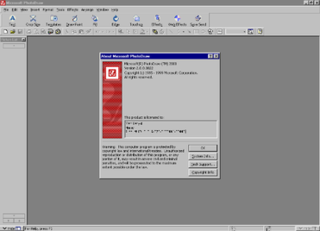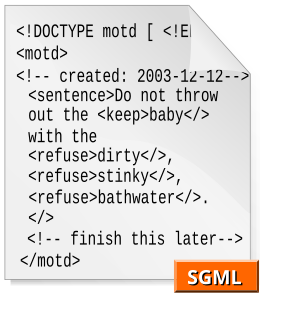An audio file format is a file format for storing digital audio data on a computer system. The bit layout of the audio data is called the audio coding format and can be uncompressed, or compressed to reduce the file size, often using lossy compression. The data can be a raw bitstream in an audio coding format, but it is usually embedded in a container format or an audio data format with defined storage layer.
ISO 8601 Data elements and interchange formats – Information interchange – Representation of dates and times is an international standard covering the exchange of date- and time-related data. It was issued by the International Organization for Standardization (ISO) and was first published in 1988. The purpose of this standard is to provide an unambiguous and well-defined method of representing dates and times, so as to avoid misinterpretation of numeric representations of dates and times, particularly when data are transferred between countries with different conventions for writing numeric dates and times.
Interchange File Format (IFF), is a generic container file format originally introduced by the Electronic Arts company in 1985 in order to facilitate transfer of data between software produced by different companies.
Audio Interchange File Format (AIFF) is an audio file format standard used for storing sound data for personal computers and other electronic audio devices. The format was developed by Apple Inc. in 1988 based on Electronic Arts' Interchange File Format and is most commonly used on Apple Macintosh computer systems.
The Resource Interchange File Format (RIFF) is a generic file container format for storing data in tagged chunks. It is primarily used to store multimedia such as sound and video, though it may also be used to store any arbitrary data.
The XML Metadata Interchange (XMI) is an Object Management Group (OMG) standard for exchanging metadata information via Extensible Markup Language (XML).

In computing, UML eXchange Format (UXF) is a XML-based model interchange format for Unified Modeling Language (UML), which is a standard software modeling language. UXF is a structured format described in 1998 and intended to encode, publish, access and exchange UML models.
The IEEE Standard for Floating-Point Arithmetic is a technical standard for floating-point arithmetic established in 1985 by the Institute of Electrical and Electronics Engineers (IEEE). The standard addressed many problems found in the diverse floating-point implementations that made them difficult to use reliably and portably. Many hardware floating-point units use the IEEE 754 standard.
The Open Document Architecture (ODA) and interchange format is a free and open international standard document file format maintained by the ITU-T to replace all proprietary document file formats. ODA is detailed in the standards documents CCITT T.411-T.424, which is equivalent to ISO 8613.
The Digital Audio Stationary Head or DASH standard is a reel-to-reel, digital audio tape format introduced by Sony in early 1982 for high-quality multitrack studio recording and mastering, as an alternative to analog recording methods. DASH is capable of recording two channels of audio on a quarter-inch tape, and 24 or 48 tracks on 1⁄2-inch-wide (13 mm) tape on open reels of up to 14 inches. The data is recorded on the tape linearly, with a stationary recording head, as opposed to the DAT format, where data is recorded helically with a rotating head, in the same manner as a VCR. The audio data is encoded as linear PCM and boasts strong cyclic redundancy check (CRC) error correction, allowing the tape to be physically edited with a razor blade as analog tape would, e.g. by cutting and splicing, and played back with no loss of signal. In a two-track DASH recorder, the digital data is recorded onto the tape across nine data tracks: eight for the digital audio data and one for the CRC data; there is also provision for two linear analog cue tracks and one additional linear analog track dedicated to recording time code.

In computing, JavaScript Object Notation (JSON) is an open-standard file format that uses human-readable text to transmit data objects consisting of attribute–value pairs and array data types. It is a very common data format used for asynchronous browser–server communication, including as a replacement for XML in some AJAX-style systems.

Microsoft PhotoDraw 2000 is a discontinued vector graphics and raster imaging software package developed by Microsoft.
Common Logic (CL) is a framework for a family of logic languages, based on first-order logic, intended to facilitate the exchange and transmission of knowledge in computer-based systems.

DVD recordable and DVD rewritable are optical disc recording technologies. Both terms describe DVD optical discs that can be written to by a DVD recorder, whereas only 'rewritable' discs are able to erase and rewrite data. Data is written ('burned') to the disc by a laser, rather than the data being 'pressed' onto the disc during manufacture, like a DVD-ROM. Pressing is used in mass production, primarily for the distribution of home video.
ISO 2709 is an ISO standard for bibliographic descriptions, titled Information and documentation—Format for information exchange.
Knowledge Interchange Format (KIF) is a computer language designed to enable systems to share and re-use information from knowledge-based systems. KIF is similar to frame languages such as KL-One and LOOM but unlike such language its primary role is not intended as a framework for the expression or use of knowledge but rather for the interchange of knowledge between systems. The designers of KIF likened it to PostScript. PostScript was not designed primarily as a language to store and manipulate documents but rather as an interchange format for systems and devices to share documents. In the same way KIF is meant to facilitate sharing of knowledge across different systems that use different languages, formalisms, platforms, etc.
Data exchange is the process of taking data structured under a source schema and transforming it into data structured under a target schema, so that the target data is an accurate representation of the source data. Data exchange allows data to be shared between different computer programs.
ISO/IEC 4909:2006 establishes specifications for financial transaction cards using track 3 and is intended to permit interchange based on the use of magnetic stripe encoded information. It specifies the data content and physical location of read/write information on track 3 and is to be used in conjunction with the relevant parts of ISO/IEC 7811 and ISO/IEC 7812.
ISO/IEC 19794 Information technology — Biometric data interchange formats — Part 5: Face image data, or ISO/IEC 19794-5 for short, is the fifth of 8 parts of the ISO standard ISO/IEC 19794, published in 2005, which describes interchange formats for several types of biometric data. ISO/IEC 19794-5 defines specifically a standard scheme for codifying data describing human faces within a CBEFF-compliant data structure, for use in facial recognition systems. Modern biometric passport photos should comply with this standard. Many organizations and have already started enforcing its directives, and several software applications have been created to automatically test compliance to the specifications.





